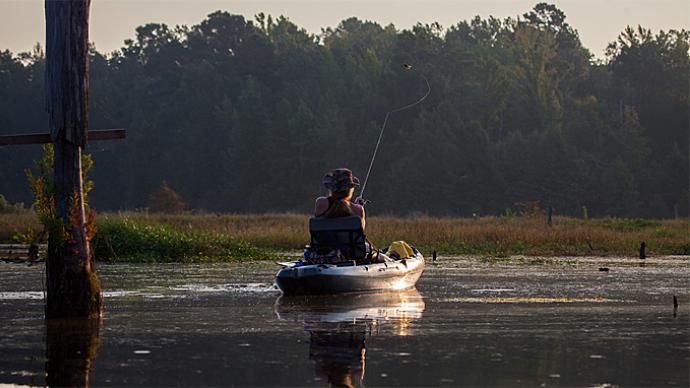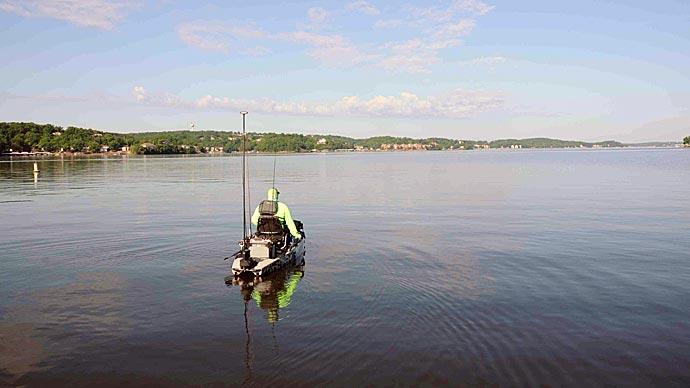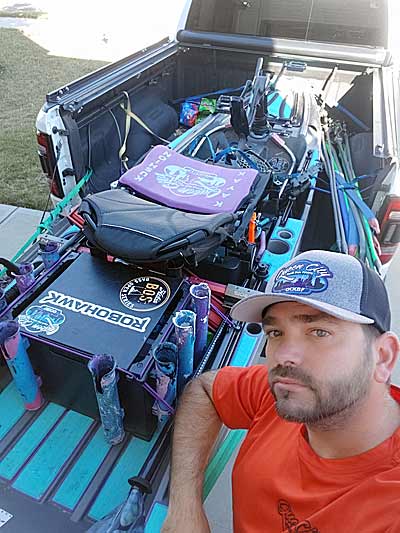
Rocketing across a reservoir in a shiny high-powered bass boat has advantages, including fishing several spots miles apart during the day. Runs of 100 miles or longer aren’t unheard of in today’s tournament fishing world. If you can pull up a spot on your GPS and stuff enough gas into your boat or find a strategically located marina to fill up, you can go until you run out of water.
Anglers who paddle or pedal a kayak — canoe or stand-up paddleboard, for that matter — have a more limited range. “The pedal guys, they’re probably going 7 to 10 miles in a day,” said Queen City Kayak Bass Fishing Founder and Tournament Director Vinny Ferreri, who also competes in Hobie Bass Open Series kayak tournaments, which take him to popular bass-fishing venues throughout the eastern United States. He said kayak anglers using paddles cover about half that distance on average.
Changing locations when fishing from a kayak takes work and isn’t always easy. Luckily, distance traveled isn’t a requirement for piecing together a productive pattern or catching more and bigger bass. Ferreri has found approaches and tactics to help you catch more bass from less water. And while these tips are aimed at kayak anglers, boat and shore anglers will benefit from them, too.
Select a starting spot
There are many unique aspects to kayak bass fishing, especially in tournaments. Instead of being held in a livewell and weighed at the end of the day as in traditional boat tournaments, bass are measured as anglers catch them. Photos of each keeper are then electronically submitted to judges back on shore for scoring. And rather than leaving from one ramp, competitors can choose among several. “That’s a huge part of this, choosing your ramp,” Ferreri said.
Less time paddling or pedaling means more time fishing. Ferreri tries to launch within 2 miles of his fishing spot. While competitors can use any public ramp during Queen City tournaments, the Charlotte, North Carolina-based club also grants them a 30-minute grace period. That’s usually enough time for him to pedal into position before the competition begins.
Determining where to start the day begins with research, including making time for practice. “Time on the water is crucial,” Ferreri said. Scouting trips are as much about finding productive water as they are about eliminating unproductive stretches. He said the practice can provide choices, too. If the weather, such as wind, changes on tournament day, you’ll have an alternative to fish. And if you’ve fished tournaments for any length of time, you know that always seems to happen.
Ferreri wants a ramp that provides access to plenty of options. Can you easily reach a main-lake point? Is there shallow water nearby? And are there enough docks where you can retreat and scrounge up at least a few bass if all else fails?
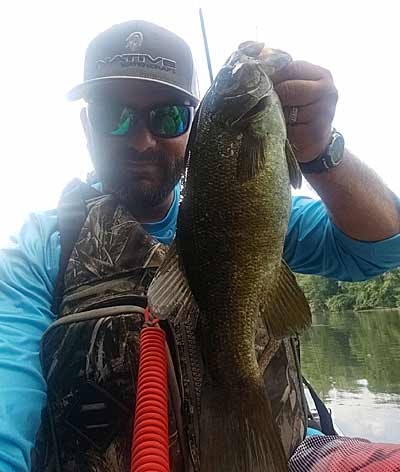
The season also steers Ferreri’s ramp choice. On Lake Wylie, the Catawba River impoundment just west of Charlotte, prespawn bass stack up on main-lake points, where they readily eat umbrella rigs, spinnerbaits, and crankbaits. Each of these points, about a 1/4-mile apart, may only give up a bass or two. So, he wants to position himself within easy reach of as many as possible.
It’s a similar situation but in a different location a few months later. Many post-spawn bass gravitate to rip-rap and rock banks, where they recover and feast on the shad spawn of early summer. Ferreri puts himself in an area where this type of cover is bountiful. That means he spends more time casting and covering water, fishing for active bass instead of traveling to the next spot.
The situation is different in summer and winter. “You may be able to sit still a bit longer,” Ferreri said. During these seasons’ respective extremes in conditions, many bass huddle together. They might gather at the end of a long point in winter or a cover-filled stretch of a river channel in summer. Either way, the presence of baitfish will attract and hold numbers of bass.
Stay in tune
The more you fish, the sharper your intuition about where to find bass and how to catch them. Ferreri put that to work at November's three-day 2021 Hobie Open Series Tournament of Champions, held on Lake Eufaula, which straddles the Georgia-Alabama line. While the winner slowly picked apart heavy cover in shallow water, he posted a top-25 finish using two spots and his experience catching bass that chase bait on points and docks on Lake Norman, the largest reservoir entirely within North Carolina.
Ferreri said fish enough, and you’ll develop a sixth sense about bass location, which can change seasonally, weekly, and even hourly. “When you’re stuck in a creek, you can feel the fish move,” he said. “You can get an excellent feel of the lake.” Instead of spending time powering your way to a different spot, you’ll notice and adapt to what’s happening around you. You’ll be more in tune with your surroundings, such as changes in water temperature, wind direction, and light levels.
Small changes can have significant impacts on bass locations and feeding. Ferreri said something as simple as the rising sun clearing the tree line can shut down surface activity and push bass deeper into shady spots or the water column. He said spawning bass can pull up on beds quickly. And a wind shift can move schooling bass from one side of a point to the other. On a recent October fishing day, Mother Nature threw weather from all four seasons at him. But you still need and want to catch bass. “It’s being in touch with your surroundings,” he said.
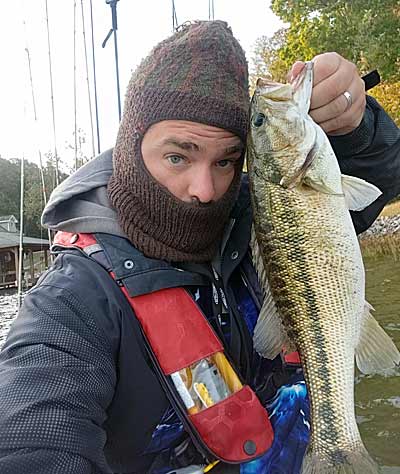
It’s easy to see how bass change through the course of a day by where and when you get the most bites. Ferreri said on an average day, fishing is good at sunrise. But it often slows by mid-morning. Then the bite is back on by late morning or early afternoon, though in a different spot, often deeper in the water column or available cover. He said it’s a similar situation at sunset. While the fishing is rarely good then, it improves once it’s pitch black and bass have repositioned.
Learn your lures
Except for the coldest days deep in winter, unless you’re fishing around a warm-water discharge, topwater or power fishing in shallow water is a powerful way to start your fishing day. And while it may keep producing if light levels stay low, whether from waves or overcast skies, you’ll need different lures and techniques to keep up with bass as they move with the changing conditions.
Ferreri said many anglers have a ton of confidence in Ned rigs or shaky heads because these finesse baits produce so many bites, including from some big bass. That makes them great options under challenging conditions, but they usually produce only enough bites from small to average size fish to equal a mid-pack finish. Instead, he encourages anglers to embrace as many lures and techniques as possible. Like a golfer who packs a club for different situations, you’ll be able to reach into your bag of tricks and pull out the one that meets a particular day’s conditions.
While you may end up fishing the same lure or technique to land a tournament-winning stringer, that doesn’t happen every day as much as we wish it would. Instead, you’ll need a host of lures and techniques to catch bass day in and day out consistently. And that’s especially true if you’re fishing only a portion of a lake, river, or reservoir.


